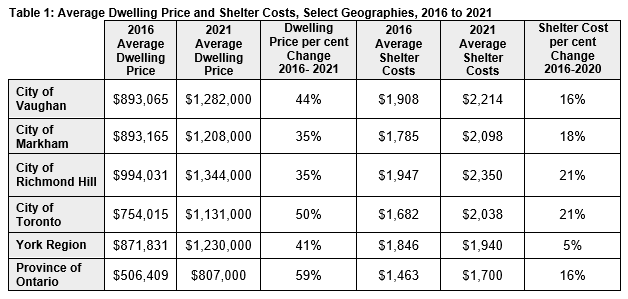2021 Census Insights and Findings – Housing Characteristics
Key highlights
- In 2021 there were 103,915 private households in the City of Vaughan: 89,290 households were owned while 14,620 were rented.
- Since 2016 the number of owned households in Vaughan increased 6 per cent from 84,490 households to 89,290, and renter households during the same period increased 50 per cent from 9,725 households to 14,620.
- Between 2016 and 2021 the average value of residential dwellings in Vaughan increased 44 per cent from $893,065 to $1,282,000.
- In 2021 18,835 occupied dwellings were condominiums. This represents an increase of 41 per cent over 2016 when 13,295 dwellings were condominiums.
- Since its peak in 2011, the Canadian homeownership rate has declined by 2.5 per cent to 66.5 per cent.
- Built dwellings in Canada are increasingly more likely to be occupied by renters, with 40 per cent of housing built between 2016 and 2021 now being tenant occupied.
INSIGHTS and Findings
Canada/Ontario
The Canadian housing market has experienced significant changes over the past decade that have led to increased discussions surrounding housing accessibility and affordability.
Since 2011 the proportion of Canadians who own their homes (or the homeownership rate) has been on the decline.
Since its peak in 2011, the Canadian homeownership rate has declined 2.5 percent to 66.5 per cent. This decline can be attributed to several factors and is most prominently connected to the densification of large urban centers.
Built dwellings, which are predominately located within large urban centers. are increasingly more likely to be occupied by renters, with 40 per cent of housing built between 2016 and 2021 now being tenant occupied.
The growth in renter households (+21.5 per cent) was more than double the growth in owner households (+8.5 per cent) from 2011 to 2021. Additionally, shares of people living alone or with roommates have risen. Those who live alone or without roommates are less likely to own their own than other households such as couples with or without children.
In Canadian metropolitan areas, the rising trend of condominium construction continues, with the share of occupied dwellings in condos increasing from 13.3 per cent in 2016 to 15 per cent in 2021.
Most of these condominium construction projects (90 per cent) are located in Canada’s largest metropolitan areas Toronto, Vancouver and Montreal.
City of Vaughan
In 2021 there were 103,915 private households in the City of Vaughan, 89,290 households owned their homes while 14,620 rented. Between 2016 and 2021 the number of renters within Vaughan increased 50 per cent from 9,725 (2016) to 14,620 (2021)
Owned dwellings in the City of Vaughan experienced a significant increase in value since the last census.
In 2021 the average value of dwellings increased 44 per cent from $893,065 in 2016 to $1,282,000 in 2021. Of owned dwellings, 59.6 per cent still had a mortgage, and 24.3 per cent were spending more than 30 per cent of their income on shelter costs. Average monthly shelter costs for homeowners in Vaughan increased 16 per cent from $1,908 in 2016 to $2,214 in 2021. In 2021 renters on average spent $2,048 on shelter costs an increase of 29 per cent or $461 since 2016. Additionally, 50.4 per cent of renters spent more than 30% of their income on shelter-related expenses.
Vaughan is a city on the rise – apartment buildings with five or more storeys accounted for 13 per cent of total occupied dwellings within the city, totalling 13,750 dwellings.
The number of dwellings in apartment buildings with five or more storeys increased by 40 per cent, adding 3,945 dwellings. In 2021 18,835 occupied dwellings were in condominiums an increase of 41 per cent from 13,295 condominium dwellings in 2016.
In 2021 the City of Richmond Hill had the highest average dwelling price at $1,344,000, the City of Vaughan was the second most expensive community for housing in York Region with an average dwelling price of $1,282,000.
Table 1 below highlights the average dwelling and shelter costs of major York Region cities, the City of Toronto, and the Province of Ontario between 2016 and 2021.

DEFINITIONS
Shelter costs refer to the average monthly total of all shelter expenses paid by households. Shelter costs for owner households include where applicable mortgage payments property taxes and condominium fees along with the costs of electricity heat water and other municipal services. For renter households, shelter costs include where applicable the rent and the costs of electricity heat water and other municipal services.
2021 CENSUS RELEASE SCHEDULE
Statistics Canada will release 2021 Census topics throughout 2022. Economic Development will continue to monitor and provide Council with information on Vaughan’s growing demographics and economy.
- 26, 2022 – Immigration, place of birth, and citizenship; ethnocultural and religious diversity; mobility and migration
- 30, 2022 – Education, labour, the language of work, commuting, and instruction in the official minority language
